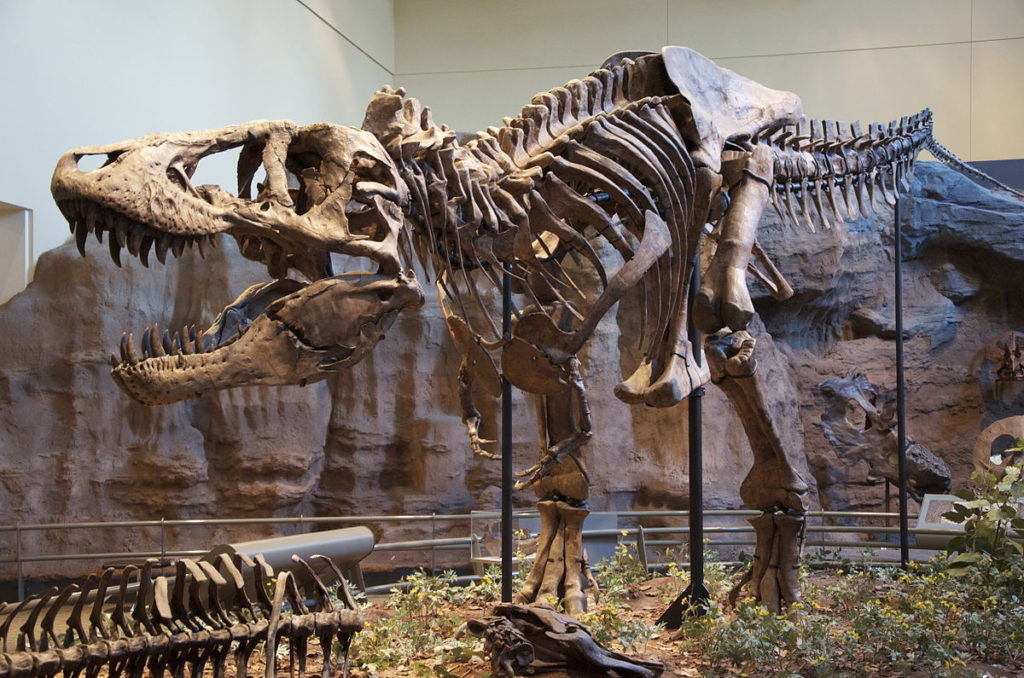Dinosaur love, as every parent knows, usually begins sometime between the ages of 4 and 9 – but the passion can go on forever. Dinosaurs are cool. See below for books, projects, interesting lesson plans, 3-D dinosaur cookies, a great dinosaur sock puppet, and the scoop on becoming a paleontologist.
Table of Contents
FICTIONAL DINOSAURS
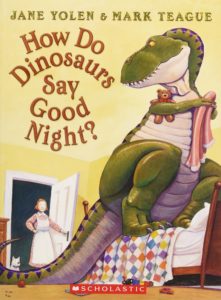
|
Jane Yolen’s How Do Dinosaurs Say Goodnight? (Blue Sky Press, 2000) is a rhyming picture-book account of how dinosaurs (and, by implication, kids) go to bed. “Does a dinosaur slam his tail and pout?/Does he throw his teddy bear all about?/Does a dinosaur stomp his feet on the floor/And shout “I want to hear one book more”?/Does a dinosaur ROAR?” No. As it turns out, they’re much better behaved. Mark Teague’s witty illustrations feature ten different oversized dinosaurs. Many good-behavior-promoting sequels, among them How Do Dinosaurs Go to School?, How Do Dinosaurs Play with Their Friends?, and How Do Dinosaurs Clean Their Room? For ages 2-7. |
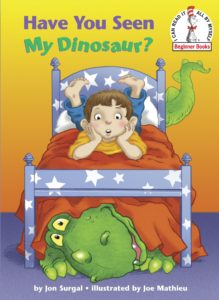
|
Jon Surgal’s Have You Seen My Dinosaur? (Random House, 2010) is a giggle-provoking hide-and-seek book in catchy rhyme. (“Have you seen my dinosaur?/He’s large. He’s green. He likes to roar.”) The dinosaur all the while is hiding in plain sight. For ages 3-6. |
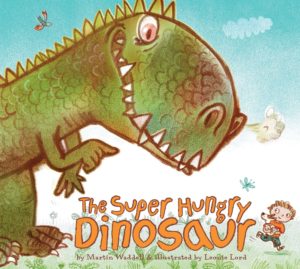
|
In Martin Waddell’s The Super Hungry Dinosaur (Dial, 2009), Hal and dog Billy are playing in the backyard when (GRRRR!) a Super Hungry Dinosaur charges in. Hal – with all the aplomb of Ogden Nash’s Isabel – defeats the dinosaur and all ends with a spaghetti dinner. For ages 3-6. |
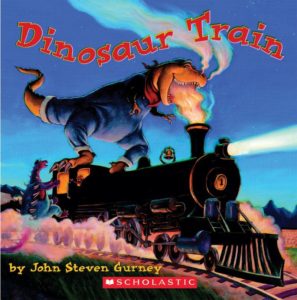
|
In John Steven Gurney’s Dinosaur Train (HarperCollins, 2002), Jesse – who loves trains and dinosaurs – is taken on a marvelous just-before-bedtime trip on a train filled with spectacular dinosaurs. For ages 3-6. |
| Check out the PBS kids’ show Dinosaur Train. Included at the site are games, a field guide to dinosaurs, videos, and a teacher’s guide. | |
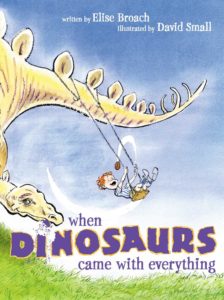
|
Elise Broach’s When Dinosaurs Came with Everything (Atheneum Books, 2010) is every kid’s dream giveaway: as a little boy and his mother run their Friday errands, every store and office is handing out free dinosaurs. (At the doughnut shop: Buy a Dozen, Get a Dinosaur.) And these are real dinosaurs. The kid collects four before his mom calls it quits, and home they go for lunch. A giggle for ages 3-7. |
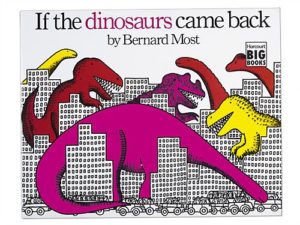
|
In Bernard Most’s If the Dinosaurs Came Back (Houghton Mifflin Harcourt, 1984), the narrator imagines what if would be like if dinosaurs were around today: they’d mow lawns and serve as ladders; people could ride to work on their backs; and they’d protect us from robbers. With catchy illustrations of big bright-colored dinosaurs. For ages 4-8. |
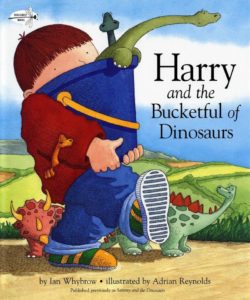
|
In Ian Whybrow’s Harry and the Bucketful of Dinosaurs (Puffin, 2012), Harry finds a cache of old plastic dinosaur toys in his grandmother’s attic, cleans them up, learns all their names, and soon carries them everywhere with him in a bucket. These are special dinosaurs: for Harry, they come to life. A problem arises when he loses his beloved dinosaurs on the train – but Harry knows just how to get them back. There are several sequels featuring Harry and his dinosaurs. For ages 4-8. |
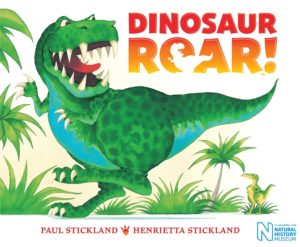
|
Paul Stickland’s Dinosaur Roar (Puffin, 2002) is an introduction to opposites, with colorful and expressive dinosaurs and a simple, but clever, rhyming text – starting with “Dinosaur roar/Dinosaur squeak/Dinosaur fierce/Dinosaur meek.” For ages 4-8. |
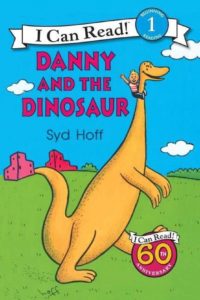
|
Syd Hoff’s Danny and the Dinosaur (HarperCollins, 2008) was originally published in 1958 and is still going strong today. Danny visits a museum where he meets a live, friendly (and appealingly blimpish) dinosaur and off the two go for an adventurous day. Sequels are Danny and the Dinosaur Go to Camp and Happy Birthday, Danny and the Dinosaur! For ages 4-8. |
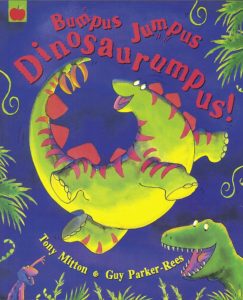
|
Tony Mitton’s Dinosaurumpus (Scholastic, 2009) is a bouncy and colorful rumpus of cavorting dinosaurs with a rhyming and onomatopoetic text (lots of Thwacks, Bomps, Donks, and EEEKs). (“Shake, shake, shudder/near the sludgy old swamp./The dinosaurs are coming./Get ready to romp!”) Readers also learn some real dinosaur names and features. For ages 4-8. |
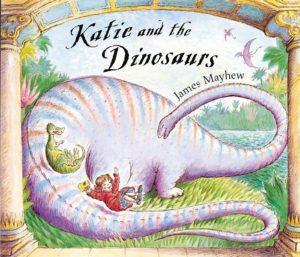
|
In James Mayhew’s Katie and the Dinosaurs (Hodder & Stoughton, 2009), Katie visits the Natural History Museum, goes through a door marked “No Admittance,” and finds herself in a prehistoric world of dinosaurs – where she helps a baby Hadrosaurus and distracts a hungry T. rex (with her lunch box). One of many Katie books. For ages 4-8. |
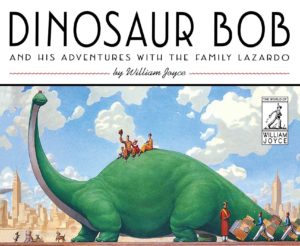
|
In William Joyce’s Dinosaur Bob and His Adventures with the Family Lazardo (HarperCollins, 1995), the adventurous Lazardo family obtains a pet dinosaur while on safari in Africa. (“He looks kind of like my uncle Bob,” said Mrs. Lazardo. So they named him Bob.) The illustrations are gorgeous, and the whole thing is topped off with “The Ballad of Dinosaur Bob” (by Zelda Lazardo), to be sung to the tune of “Auld Lang Syne.” For ages 4-8. |
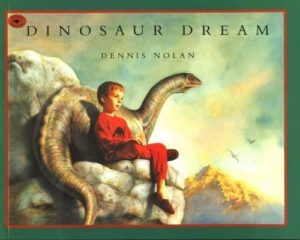
|
In Dennis Nolan’s Dinosaur Dream (Aladdin, 1994), Wilbur wakes up to find a lost baby Apatosaurus outside his bedroom window. He names it Gideon (after paleontologist Gideon Mantell) and sets off on a 140-million-year-long trip through time to take it safely home again. Lovely pseudo-realistic illustrations. For ages 4-8. |
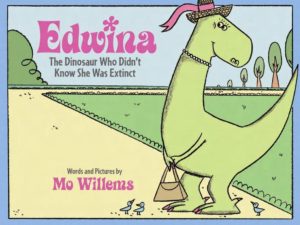
|
In Mo Willems’s Edwina, The Dinosaur Who Didn’t Know She Was Extinct (Hyperion Books, 2006), Edwina is a sweetheart of a dinosaur who helps old ladies cross the street and bakes chocolate chip cookies. She’s loved by all, except Reginald Von Hoobie-Doobie, who insists – with lecture, illustrations, and a pointer – that the dinosaurs are TOTALLY EXTINCT. Edwina is horrified. For ages 4-8. |
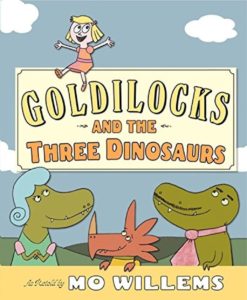
|
In Mo Willems’s hysterical Goldilocks and the Three Dinosaurs (Balzer + Bray, 2012), the dinosaurs make the beds, arrange the chairs, set out three tempting bowls of chocolate pudding heated to various temperatures, and go for a walk. Says Mama Dinosaur, “I SURE HOPE NO INNOCENT LITTLE SUCCULENT CHILD HAPPENS BY OUR UNLOCKED HOME WHILE WE ARE…uhh…SOMEPLACE ELSE!” Luckily visiting Goldilocks wises up before she becomes a dinosaur bon-bon. For ages 5 and up. |
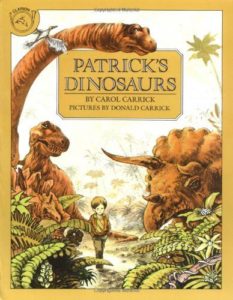
|
In Carol Carrick’s Patrick’s Dinosaurs (Houghton Mifflin Harcourt, 1985), Patrick learns all about dinosaurs from his brother, Hank, and then becomes convinced that a fearsome T. rex has followed them home – until Hank explains that the dinosaurs are long gone. Sequels include What Happened to Patrick’s Dinosaurs? – in which Hank explains the science of why the dinosaurs became extinct, while Patrick imagines a world of friendly dinosaurs helping people until they finally left Earth in a spaceship – and Patrick’s Dinosaurs on the Internet (no science whatsoever) in which Patrick takes a trip to the distant dinosaur planet. For ages 5-8. |
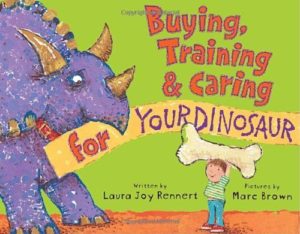
|
Laura Joy Rennert’s Buying, Training and Caring for Your Dinosaur (Knopf Books for Young Readers, 2009) is a hilarious spoof on choosing a dinosaur pet. What kind, for example, is best for you? Horned? “With his bony frill and three horns, Triceratops is a great watch-dino. Please post a BEWARE OF DINO sign. Your mail carrier will appreciate this.” For ages 5-8. |
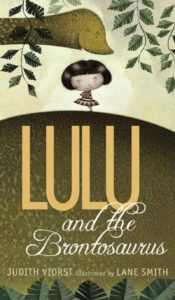
|
In Judith Viorst’s Lulu and the Brontosaurus (Atheneum Books for Young Readers, 2010) – with terrific illustrations by Lane Smith – Lulu, denied a brontosaurus for her birthday, throws a screaming fit, then packs a pickle sandwich and heads off into the woods to find a brontosaurus for herself. When she finally finds one, a problem arises: the brontosaurus wants to keep Lulu as a pet. Readers get a choice of three different endings. Funny, clever, and a helpful lesson in behavior for ages 5-9. |
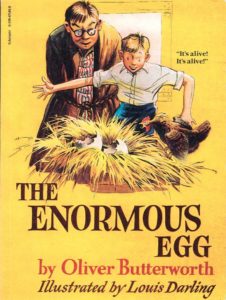
|
In Oliver Butterworth’s The Enormous Egg (Little, Brown Books for Young Readers, 1993), young Nate Twitchell is flabbergasted when an oversized egg from the family chicken coop in Freedom, NH, hatches out an infant Triceratops. Soon scientists and politicians converge on the farm, and Nate is confronted with the problem of what’s best to do with his dinosaur. For ages 8-12. |
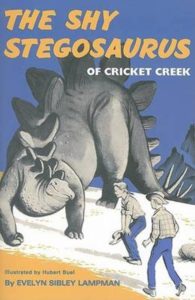
|
In Evelyn Sibley Lampman’s The Shy Stegosaurus of Cricket Creek (Purple House Press, 2007), twins Joan and Joey Brown – out hunting fossils in the desert – find far more than they bargained for: a live Stegosaurus (George) who likes bananas and speaks English. For ages 8-12. |
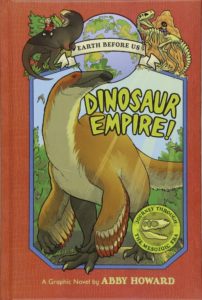
|
Abby Howard’s Dinosaur Empire! (Amulet, 2017) is a graphic novel in which Ronnie and next-door neighbor Ms. Lernin, a retired paleontologist, go back in time to visit the three periods of the Mesozoic Era: the Triassic, Jurassic, and Cretaceous. One of the Earth Before Us series. For ages 9-12. |
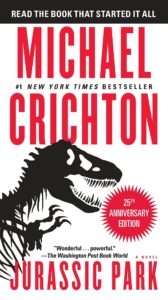
|
In Michael Crichton’s Jurassic Park (Ballantine Books, 2012), the dinosaurs are back – cloned from blood samples in ancient amber – and they’re smart and dangerous. In the sequel, Lost World, they’re back again. Exciting reads for teenagers and adults. |
| Steven Spielberg’s 1993 film version of Jurassic Park stars Sam Neill, Laura Dern, and lot of spectacular dinosaurs. Rated PG-13. |
